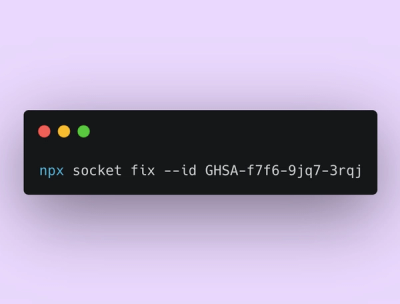
Product
Rust Support Now in Beta
Socket's Rust support is moving to Beta: all users can scan Cargo projects and generate SBOMs, including Cargo.toml-only crates, with Rust-aware supply chain checks.
@geoffcox/react-splitter
Advanced tools
A splitter for React components that leverages CSS grid templates for simple and consistent resizing.
A resizable splitter for React that leverages CSS display:grid
See the ../Readme.md for features, version history, etc.
npm install --save @geoffcox/react-splitter
To create vertical or horizontal splits you only need the Split component.
The default creates a left|right split down the middle, no minimum pane sizes, and renders the default splitter.
<Split>
<div>This is the left pane.</div>
<div>This is the right pane.<div>
</Split>
Add the horizontal attribute to split top/bottom.
<Split horizontal>
<div>This is the top pane.</div>
<div>This is the bottom pane.<div>
</Split>
Add the initialPrimarySize property to control where the initial split occurs.
<Split initialPrimarySize='30%'>
<div>Primary pane</div>
<div>Secondary pane<div>
</Split>
To support double-clicking to reset back to the initial size, add the resetOnDoubleClick property.
<Split initialPrimarySize='30%' resetOnDoubleClick>
<div>Primary pane</div>
<div>Secondary pane<div>
</Split>
Just nest Split componets to create whatever layout you like. Here is an example of a common layout for a main, detail, and output view.
<Split initialPrimarySize='30%'>
<div>This is the left pane.</div>
<Split horizontal initialPrimarySize='60%'>
<div>This is the right-top pane.</div>
<div>This is the right-bottom pane.</div>
</Split>
</Split>
You can prevent either pane from becoming too small using the minPrimarySize and minSecondarySize properties.
For vertical splits, primary is the left pane and secondary is the right pane.
For horizontal splits, primary is the top pane and secondary is the bottom pane.
<Split minPrimarySize='250px' minSecondarySize='15%'>
<div>This pane won't get smaller than 250 pixels.</div>
<div>This pane won't get any smaller than 15% of the overall size of the split control./<div>
</Split>
You can set the size of the hit area (where the user can click to start draggin the splitter) with the splitterSize property.
<Split splitterSize='10px'>
<div>Primary pane</div>
<div>Secondary pane<div>
</Split>
You can change the colors of the default splitter with the defaultSplitterColors property.
const colors = {
color: 'red',
hover: '#00FF00',
drag: 'blue'
};
<Split defaultSplitterColors={colors}>
<div>Primary pane</div>
<div>Secondary pane<div>
</Split>
You can render your own splitter by passing a callback to the renderSplitter property.
const renderSplitter = (props: RenderSplitterProps) => {
return <div>Your splitter code goes here.</div>
};
<Split renderSplitter={renderSplitter}>
<div>Primary pane</div>
<div>Secondary pane<div>
</Split>
The callback receives the RenderSplitterProps to let you know the current size of the splitter, if the split is horizontal, and if the splitter is currently being dragged.
export type RenderSplitterProps = {
pixelSize: number;
horizontal: boolean;
dragging: boolean;
};
You can use event callbacks to monitor changes to the primary size and the measured sizes. The primary size is a CSS unit string (percentage or initial size). The measured sizes are pixels sizes.
const onSplitChanged = (primarySize: string) => {
console.log(`The split is: ${primarySize}`);
};
const onMeasuredSizesChanged = (sizes: SplitMeasuredPixelSizes) => {
console.log(`The primary pane is: ${sizes.primary}px`);
console.log(`The splitter is: ${sizes.splitter}px`);
console.log(`The secondary pane is: ${sizes.secondary}px`);
};
<Split onSplitChanged={onSplitChanged} onMeasuredSizesChanged={onMeasuredSizesChanged}>
<div>Primary pane</div>
<div>Secondary pane<div>
</Split>
If you are using a style framework like Fluent, Material UI, or Bootstrap then your root div will likely have CSS styles applied that help this splitter work correctly. If you have no root stylesheet, you might have problems with vertical scrolling.
Here are some recommended CSS properties for your top-level divs if you are building a single-page application. In this case #app is the mounting point for React.Render. You can see this approach used in the demo application.
body {
height: 100vh;
position: absolute;
top: 0;
right: 0;
bottom: 0;
left: 0;
overflow: hidden;
padding: 0;
margin: 0;
}
body,
div {
box-sizing: border-box;
}
#app {
position: relative;
box-sizing: border-box;
width: 100%;
height: 100%;
outline: none;
overflow: hidden;
}
FAQs
A splitter for React components that leverages CSS grid templates for simple and consistent resizing.
We found that @geoffcox/react-splitter demonstrated a not healthy version release cadence and project activity because the last version was released a year ago. It has 1 open source maintainer collaborating on the project.
Did you know?

Socket for GitHub automatically highlights issues in each pull request and monitors the health of all your open source dependencies. Discover the contents of your packages and block harmful activity before you install or update your dependencies.

Product
Socket's Rust support is moving to Beta: all users can scan Cargo projects and generate SBOMs, including Cargo.toml-only crates, with Rust-aware supply chain checks.

Product
Socket Fix 2.0 brings targeted CVE remediation, smarter upgrade planning, and broader ecosystem support to help developers get to zero alerts.

Security News
Socket CEO Feross Aboukhadijeh joins Risky Business Weekly to unpack recent npm phishing attacks, their limited impact, and the risks if attackers get smarter.